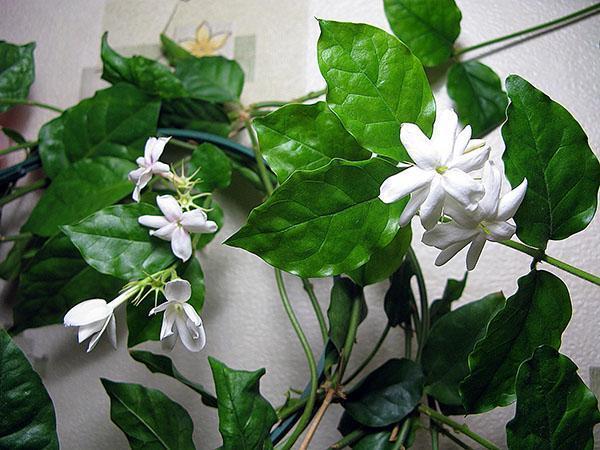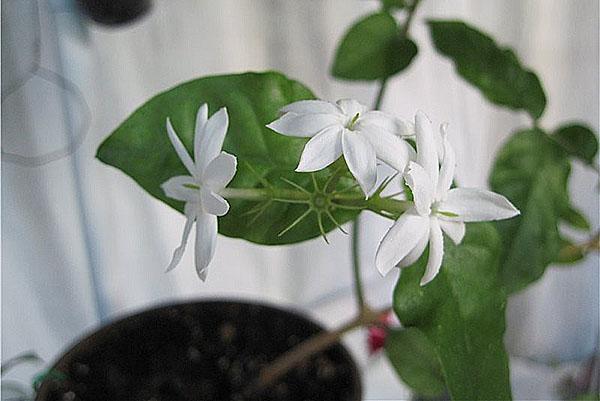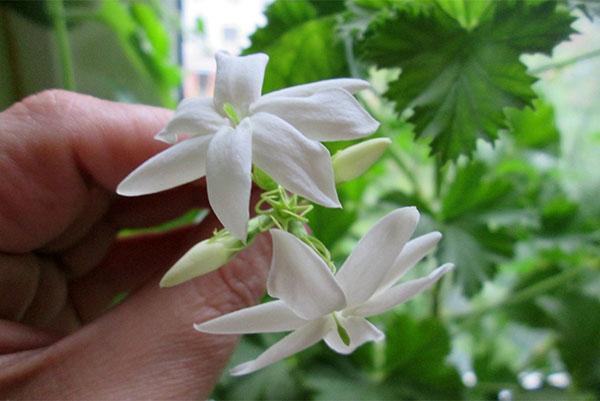The intricacies of growing and caring for Sambac jasmine
 Jasmine Sambac is a great houseplant that will adorn any interior. Evergreen shrub means fragrant jasmine. It enchants experienced florists and simple housewives with its aroma and attractive appearance. To grow it at home, you need to have information about the characteristics of these crops. The photo of Sambac jasmine clearly shows the beauty of the leaves and flower of the plant.
Jasmine Sambac is a great houseplant that will adorn any interior. Evergreen shrub means fragrant jasmine. It enchants experienced florists and simple housewives with its aroma and attractive appearance. To grow it at home, you need to have information about the characteristics of these crops. The photo of Sambac jasmine clearly shows the beauty of the leaves and flower of the plant.
Jasmine Sambac traits
This plant belongs to evergreen climbing or climbing shrubs. Leaves are simple, trifoliate, pinnate, ovate, leathery, from 2-10 cm long, which are located opposite each other. Sambac jasmine flowers have a regular, double or semi-double, elongated shape of a thin tube that blooms at the edge. Their cup is approximately 1 cm.
The peculiarity of such a plant is that it has an upper ovary, which becomes a berry during the ripening period. There are corollas of jasmine flowers in white, red or yellow shades. The stems of such a shrub are thin, brown in color, resembling tree branches.
The flowering of indoor jasmine Sambac lasts for several months; under favorable conditions and proper care, it can last all year.
Read also the article: myrtle flower care at home!
Jasmine Sambac
This plant has several subspecies. Among florists, the following varieties are most popular:
- Jasmine Beauty of India. This species was bred by Indian breeders. It belongs to the category of fast growing shrubs or vines. It is characterized by regular shaped flowers with two stamens located inside. This jasmine can bloom all year round.

- Jasmine Arab Knights. This plant belongs to the rapidly growing bushes. Favorable conditions for growing are sunny and shady places. Watering should be moderate. This variety blooms from March to October.

- Jasmine Indiana. For the first time this species began to be grown in India. Outwardly, the plant is similar to both a shrub and a liana. The diameter of its fragrant and double flowers is 1.5 cm. It can bloom both on the sunny side and in the shade all year round. Watering should be moderate. Compared to other varieties, this plant requires a higher air temperature for flowering.

- Jasmine Mali Chat. Refers to slow growing shrubs. The diameter of the stocky, double flowers is 1.5 cm. Growing and caring for it requires certain knowledge and skills. Like most Sambac jasmine, it blooms all year round in the shade and on the sunny side.

- Jasmine Maid of Orleans. It is considered a fast growing shrub. This species was bred by Indian breeders. Flowers of the correct form in a blossoming state are one day, after which they fall, instead of them new ones fall. When growing this type, an excess of soil moisture should not be allowed.

Before growing any variety in a residential area, it is necessary to carefully study the characteristics of the plant and how to care for Sambac jasmine at home.
Jasmine Sambac care

In order to grow a healthy and beautiful indoor jasmine, you need to provide proper care for it, namely:
- Choose a suitable growing area.This is a light-loving culture. In winter, for good growth and flowering, you need to provide it additional lightingso that daylight hours last at least sixteen hours. Otherwise, the jasmine may die.
- Create an optimal air temperature. It is necessary to grow and care for sambac jasmine in a room where the temperature will be in the range of 16-20 degrees in winter, and in summer it will not exceed 25-30 degrees.
- Provide regular watering. This indoor plant needs constant and moderate watering. In a cool room, watering is not necessary often, and in dry air, intensive humidification is required.
- Pruning, feeding the plant. In order for the jasmine bush to grow beautiful and neat, it is necessary to prune it with the onset of spring. Weak and thin shoots must be completely removed, and long ones should be shortened by two-thirds. After the end of the first wave of flowering, the stems must be pinched or slightly trimmed. In this way, a new growth of flower shoots will start. Once a month, o fertilize the plant with special agents, which include phosphorus, potassium, nitrogen.

Young Sambac jasmine should be transplanted into larger pots annually. Adult shrubs should be transplanted every two years.
Many housewives are faced with the question - what to do if jasmine does not bloom? There may be several reasons for this:
- insufficient soil moisture;
- dry or cold indoor air;
- not acidic enough soil;
- the use of chlorinated tap water to moisten the soil;
- deepening of the root collar when planting in the soil by more than 3 cm.
Having eliminated these reasons and providing proper care, such a shrub will bloom for more than one year.
Can jasmine sambac be delivered to tea?
It is from sambac that you get the most aromatic jasmine tea. The jasmine that grows in the garden and is called garden jasmine does not have such a smell, and after drying it generally looks like grass. Moreover, in fact, it is a mock-orange, a representative of the hydrangea family. And fragrant sambac is just a real jasmine (one of its types), native to the mild climate of South Asia. We grow it as a houseplant.